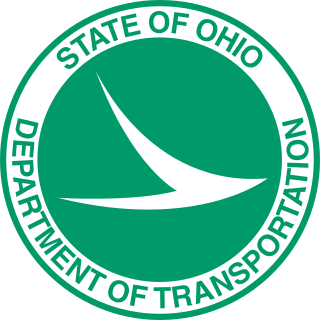Related Research Articles

Transportation engineering or transport engineering is the application of technology and scientific principles to the planning, functional design, operation and management of facilities for any mode of transportation to provide for the safe, efficient, rapid, comfortable, convenient, economical, and environmentally compatible movement of people and goods transport.

Traffic engineering is a branch of civil engineering that uses engineering techniques to achieve the safe and efficient movement of people and goods on roadways. It focuses mainly on research for safe and efficient traffic flow, such as road geometry, sidewalks and crosswalks, cycling infrastructure, traffic signs, road surface markings and traffic lights. Traffic engineering deals with the functional part of transportation system, except the infrastructures provided.

Highway engineering is a professional engineering discipline branching from the civil engineering subdiscipline of transportation engineering that involves the planning, design, construction, operation, and maintenance of roads, highways, streets, bridges, and tunnels to ensure safe and effective transportation of people and goods. Highway engineering became prominent towards the latter half of the 20th century after World War II. Standards of highway engineering are continuously being improved. Highway engineers must take into account future traffic flows, design of highway intersections/interchanges, geometric alignment and design, highway pavement materials and design, structural design of pavement thickness, and pavement maintenance.

A road surface or pavement is the durable surface material laid down on an area intended to sustain vehicular or foot traffic, such as a road or walkway. In the past, gravel road surfaces, macadam, hoggin, cobblestone and granite setts were extensively used, but these have mostly been replaced by asphalt or concrete laid on a compacted base course. Asphalt mixtures have been used in pavement construction since the beginning of the 20th century and are of two types: metalled (hard-surfaced) and unmetalled roads. Metalled roadways are made to sustain vehicular load and so are usually made on frequently used roads. Unmetalled roads, also known as gravel roads or dirt roads, are rough and can sustain less weight. Road surfaces are frequently marked to guide traffic.

The Council of Scientific and Industrial Research is a research and development (R&D) organisation in India to promote scientific, industrial and economic growth. Headquartered in New Delhi, it was established as an autonomous body in 1942 under the aegis of the Department of Scientific and Industrial Research (DSIR), Ministry of Science and Technology, Government of India. CSIR is among the largest publicly funded R&D organisations in the world. CSIR has pioneered sustained contribution to science and technology (S&T) human resource development in India.

The Maryland State Highway Administration is the state mode responsible for maintaining Maryland's numbered highways outside Baltimore. Formed originally under authority of the General Assembly of Maryland in 1908 as the State Roads Commission (SRC), under the direction of the executive branch of state government headed by the governor of Maryland, it is tasked with maintaining non-tolled/free bridges throughout the state, removing snow from the state's major thoroughfares, administering the state's "adopt-a-highway" program, and both developing and maintaining the state's freeway/expressway system. There was a reorganization of the several commissions, bureaus, boards, and assorted minor agencies with departments of the executive branch and establishment of the governor's cabinet in the early 1970s following the adoption of several individual reorganization recommendations after the rejection by the voters in a November 1968 referendum of the 1968 proposed overall new state constitution prepared by the 1967–1968 Constitutional Convention. SHA is now a division of the larger establishment of the Maryland Department of Transportation and is currently overseen by an administrator.

The Ohio Department of Transportation is the administrative department of the Ohio state government responsible for developing and maintaining all state and U.S. roadways outside of municipalities and all Interstates except the Ohio Turnpike. In addition to highways, the department also helps develop public transportation and public aviation programs. ODOT is headquartered in Columbus, Ohio. Formerly, under the direction of Michael Massa, ODOT initiated a series of interstate-based Travel Information Centers, which were later transferred to local partners. The Director of Transportation is part of the Governor's Cabinet.
A green highway is a roadway constructed per a relatively new concept for roadway design that integrates transportation functionality and ecological sustainability. An environmental approach is used throughout the planning, design, and the construction. The result is a highway that will benefit transportation, the ecosystem, urban growth, public health and surrounding communities.

The Indian Institute of Petroleum (IIP), established in 1960, is one of the 37 constituent laboratories of the Council of Scientific and Industrial Research (CSIR), dedicated to R&D in the hydrocarbon sector.
Central Scientific Instruments Organisation is a Chandigarh, India-based national laboratory dedicated to research, design and development of scientific, and industrial instruments. It is one of the constituent laboratories of the Council of Scientific and Industrial Research (CSIR), an Indian industrial research and development organisation situated at Chandigarh's Sector 30-C.
Pavement management is the process of planning the maintenance and repair of a network of roadways or other paved facilities in order to optimize pavement conditions over the entire network.
The National Environmental Engineering Research Institute (NEERI) in Nagpur was originally established in 1958 as the Central Public Health Engineering Research Institute (CPHERI). It has been described as the "premier and oldest institute in India." It is an institution listed on the Integrated Government Online Directory. It operates under the aegis of the Council of Scientific and Industrial Research (CSIR), based in New Delhi. Indira Gandhi, the Prime Minister of India at the time, renamed the Institute NEERI in 1974.

The Ministry of Highways is divided into the Operations, Policy and Programs, and Corporate Services Divisions and the Communications Branch. The ministry is the employer of over 1,476 employees diversified amongst 105 communities in Saskatchewan. The current Minister of Highways and Infrastructure is Jeremy Cockrill.

The Ministry of Road Transport and Highways (MoRTH) is a ministry of the Government of India, that is the apex body for formulation and administration of the rules, regulations and laws relating to road transport, transport research and in also to increase the mobility and efficiency of the road transport system in India. Through its officers of Central Engineering Services (Roads) cadre it is responsible for the development of National Highways of the country.

The international roughness index (IRI) is the roughness index most commonly obtained from measured longitudinal road profiles. It is calculated using a quarter-car vehicle math model, whose response is accumulated to yield a roughness index with units of slope. Although a universal term, IRI is calculated per wheelpath, but can be expanded to a Mean Roughness Index (MRI) when both wheelpath profiles are collected. This performance measure has less stochasticity and subjectivity in comparison to other pavement performance indicators, such as PCI, but it is not completely devoid of randomness. The sources of variability in IRI data include the difference among the readings of different runs of the test vehicle and the difference between the readings of the right and left wheel paths. Despite these facts, since its introduction in 1986, the IRI has become the road roughness index most commonly used worldwide for evaluating and managing road systems.

CSIR-Structural Engineering Research Centre (CSIR-SERC), Chennai is one of the 38 constituent laboratories of the Council of Scientific and Industrial Research in India. The institute is a certified ISO:9001 quality institute.

The Central Institute of Road Transport (CIRT) is a Government of India undertaking, established under the then Ministry of Shipping and Transport and the Association of State Road Transport Undertakings (ASTRU). It is a nodal agency, known to be only one of its kind, providing a platform for higher research and training on road transportation and assists in testing, guidance and consultancy in the field.

The Communication and Works Department is a department of the Government of Punjab, Pakistan. It is responsible for the planning, execution, maintenance, and repair of infrastructure projects in the province, including bridges, public buildings, and roads.

UiTM Faculty of Civil Engineering is one of the professional graduate faculty of UiTM located in Shah Alam, Malaysia.
The rolling straight-edge is an instrument used to measure the surface regularity of roads and similar structures such as airport runways. It consists of a straightedge of a fixed distance mounted on wheels with a sensor at the centrepoint measuring deviation in height. It is rolled along the road surface and set to specific trigger levels which can be logged automatically or by means of an audible alarm. The rolling straight-edge was developed by the British Road Research Laboratory to replace earlier manual methods of measurement using rulers. It has been used by several countries and remains in use in the United Kingdom, Germany and Taiwan.
References
- ↑ "Delhi Metro breaks passenger record again in August". Indiatoday.in. 9 August 2014. Retrieved 1 August 2016.
- ↑ "Past Directors of CRRI". CSIR-CRRI. Retrieved 16 July 2022.